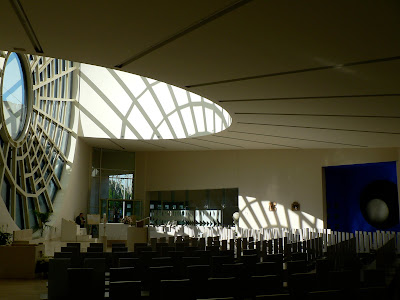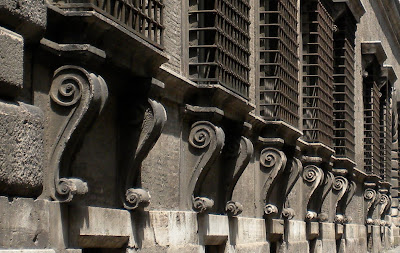According to the tradition, Peter asked Jesus: "Domine, quo vadis? - Lord, where are you going?" And Jesus answered: "Eo Romam iterum crucifigi - I go to Rome to be crucified anew."
This convinced Peter to turn around and face martyrdom in Rome. The church markes the legendary spot where this meeting of St. Peter and Jesus took place. The first church on this site was built in the 9th century. The present building dates from the 17th century. The limited decoration and ornamentation inside is an interesting mix of items and styles. In the center of the floor is a marble slab with two footprints (being a copy of the original that is now preserved in the Basilica of San Sebastiano down the road) that people believe were a miraculous sign left by Jesus when he met Peter.
The first church on this site was built in the 9th century. The present building dates from the 17th century. The limited decoration and ornamentation inside is an interesting mix of items and styles. In the center of the floor is a marble slab with two footprints (being a copy of the original that is now preserved in the Basilica of San Sebastiano down the road) that people believe were a miraculous sign left by Jesus when he met Peter.
 When your eyes look to the left, there is a modern column with a bust of Henryk Sienkiewicz, the Polish author of the historical fiction novel Quo Vadis: A Narrative of the Time of Nero. It is said that Sienkiewicz was inspired to write his novel while sitting in this church. A painting of St. Peter seems to be looking at the author. (Quo Vadis has been made into a movie several times. The first was in 1951 and the most recent film version was in 2001.)
When your eyes look to the left, there is a modern column with a bust of Henryk Sienkiewicz, the Polish author of the historical fiction novel Quo Vadis: A Narrative of the Time of Nero. It is said that Sienkiewicz was inspired to write his novel while sitting in this church. A painting of St. Peter seems to be looking at the author. (Quo Vadis has been made into a movie several times. The first was in 1951 and the most recent film version was in 2001.)
This convinced Peter to turn around and face martyrdom in Rome. The church markes the legendary spot where this meeting of St. Peter and Jesus took place.
 The first church on this site was built in the 9th century. The present building dates from the 17th century. The limited decoration and ornamentation inside is an interesting mix of items and styles. In the center of the floor is a marble slab with two footprints (being a copy of the original that is now preserved in the Basilica of San Sebastiano down the road) that people believe were a miraculous sign left by Jesus when he met Peter.
The first church on this site was built in the 9th century. The present building dates from the 17th century. The limited decoration and ornamentation inside is an interesting mix of items and styles. In the center of the floor is a marble slab with two footprints (being a copy of the original that is now preserved in the Basilica of San Sebastiano down the road) that people believe were a miraculous sign left by Jesus when he met Peter. When your eyes look to the left, there is a modern column with a bust of Henryk Sienkiewicz, the Polish author of the historical fiction novel Quo Vadis: A Narrative of the Time of Nero. It is said that Sienkiewicz was inspired to write his novel while sitting in this church. A painting of St. Peter seems to be looking at the author. (Quo Vadis has been made into a movie several times. The first was in 1951 and the most recent film version was in 2001.)
When your eyes look to the left, there is a modern column with a bust of Henryk Sienkiewicz, the Polish author of the historical fiction novel Quo Vadis: A Narrative of the Time of Nero. It is said that Sienkiewicz was inspired to write his novel while sitting in this church. A painting of St. Peter seems to be looking at the author. (Quo Vadis has been made into a movie several times. The first was in 1951 and the most recent film version was in 2001.) 
















































